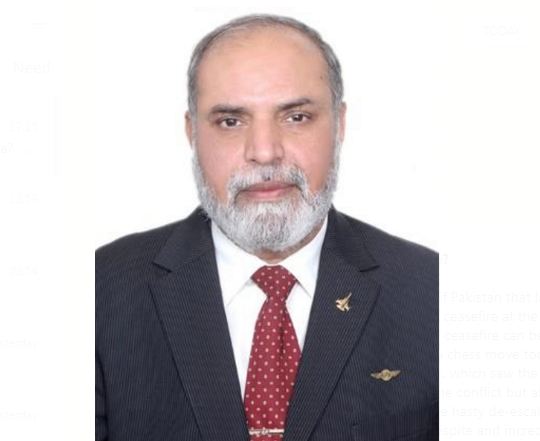by: Dr Air Commodore Naveed Khaliq Ansaree (Retd)
The May 2025 failed Indian military intimidation of Pakistan that lasted four days, ended in a US-brokered and uncomfortable ceasefire at the request of India. In a volatile region like South Asia, the term ceasefire can be construed not just a diplomatic nicety or delicacy; it can be a chess move too. Following the high-tension clash of military forces, which saw the Indian Air Force (IAF) not only face setbacks at all levels of the conflict but also ground in the narrative and dialectic of opposing wills. The hasty de-escalation between India and Pakistan has prompted both respite and incredulity. Was this ceasefire a calculated step toward stability in the region, or is it a strategic-pause that IAF needed to regroup, recalibrate, and reclaim the honour that it had lost in the skies of South Asia?
The four-day conflict wasn’t just a tactical and operational failure, rather it was a dark chapter and symbolic blow to the IAF, a force that had spent almost a decade modernising fleets, integrating Artificial Intelligence (AI), and projecting itself as a modern air power and net-security-provider in the region. It revealed that hardware and media-highlights do not replace doctrinal-tenets, operational-cohesion and battlefield-precision. The military volley of shock and awe cost India loss of professional pride in the comity of modern air forces. Having lost six of IAF’s combat aircraft including three flagship Rafales, theS-400 air defence system, multimillion dollar Israeli drones, and control over the skies, India was unable to withstand the might, discipline and tactical brilliance of PAF’s full-spectrum Multi Domain Operations as indoctrinated by the Chief of the Air Staff Pakistan Air Force, Air Chief Marshal Zaheer Ahmed Baber Sidhu.
The ceasefire may not hold long. Unfortunately, in its attempt to teach Pakistan a lesson, India ended up introducing an undesired new normal for the application of military instrument, and precariously lowering the threshold of a hot war with Pakistan. A small false-flag, foreign-sponsored or home-grown terrorist incident could act as a trigger point for an all-out war between the two nuclear neighbours. And also, on the pretext of a small terrorist incident, India may get incited to seize the opportunity to reclaim the lost honour.
Against this backdrop, the ceasefire agreement renewed between India and Pakistan in June 2025 is riddled with strategic ambiguity. There were no major peace talks, no back-channel diplomacy, no India’s renunciation of unilateral suspension of the Indus Water Treaty that had stood the test of several full-fledged wars and eye-ball to eye-ball military standoffs. For Pakistan, the rationale for accepting the ceasefire is clearer: genuine desire to promote peace, a fragile economy, and securing good-will in the international community particularly with the key allies like China and the Gulf states. But for India, particularly its military establishment, the motivation to accept discomforting ceasefire from the position of weakness is more layered. Could this ceasefire be less about the peace and more about time; a recouping space for the IAF to step back, evaluate the lost air battle, fix doctrinal and training fault lines, and silently prepare for the next round with a firmer grip to reclaim the lost pride?
Honour in the military sense isn’t only about pride; it includes competence, credibility, and public perception. The IAF, despite being one of the most professionally-skilled air forces in the region, knows the weight of negative perception. The post-Pulwama embarrassment had set a high bar for the IAF for the operational performance and strategic messaging that led to the trumpeted induction of flagship fighter aircraft “Rafales”; the post-Phalgam debacle delivered confusion adding insult to the professional injury. Since then, intelligence and surveillance suggest that the IAF has been working inaudibly on several areas: enhancing real-time battlefield data links, fixing command chain disruptions, hurried induction of military equipment and refining jointness with other services. There is also talk of reassessing doctrinal flexibility, and extending tactical commanders a greater freedom of decision-making in a dynamic battlespace.
In my opinion, the shadow of the next crisis is still looming large over South Asia. That next moment of truth may come in the form of another terror attack, a drone incursion, or a Ukrainian style sabotage action. When the moment arrives, the real test will be whether the IAF’s current period of silence was indeed a strategic pause or merely a retreat from embarrassment. Ceasefires are rarely about peace in South Asia; they are about repositioning and silence before the storm. The IAF may have lost a battle for narrative-control in May 2025, it hasn’t loss the will. IAF may use the time-out to reflect, reform, or re-strategise; proving this ceasefire wasn’t a guised-surrender, but the prelude to the restoration and reclamation of the pride lost in the skies of South Asia.
The writer, Dr Air Commodore Naveed Khaliq Ansaree (Retd), is a Director at the Centre for Aerospace & Security Studies (CASS), Lahore. He can be reached at [email protected]

















